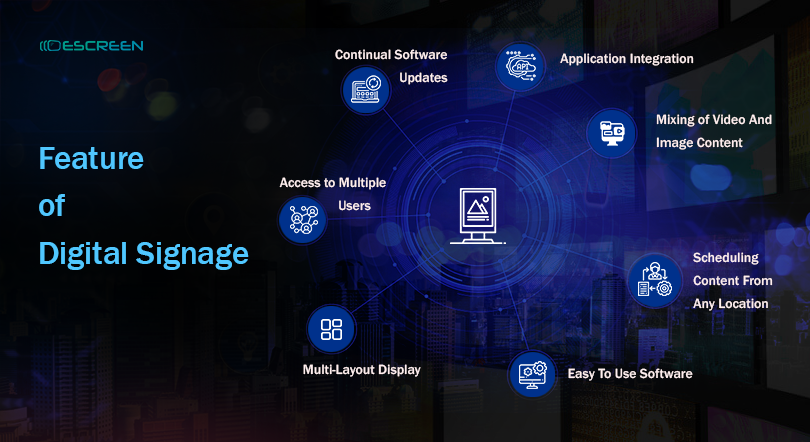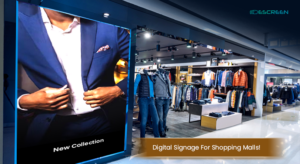Different business owners use digital signage, which is electronic signage or a digital sign, for displaying advertising and promotional messages. These digital signs use LCD screens and LED bright lights with colorful, appealing, and protruding texts to attract a huge number of customer to their store. However digital signage has strategically replaced the traditional printed or handwritten signage which once dominated the marketplace. Also, almost every industry and sector in the country, including restaurant businesses, retail stores, office buildings, educational hubs, manufacturing units, the hotel industry, hospitals, banks, the airline industry, etc., utilize digital signage these days. To surpass your competitors in the market you need to definitely introduce this in your business to generate a huge customer base and demand. Digital signage shall definitely help your business to grow and generate revenue.
Restaurant businesses use these digital signboards to display their extensive and colorful food menus to attract customers. The stores in the shopping malls put up digital screens or displays to advertise their store, products that are on sale, seasonal offers, discounts, and other important information that can make the shopping experience of the customers enjoyable. The digital signage solution or software is indeed highly customizable, allowing modification according to the needs of the business, the changing needs of the customers, and market trends. It reduces a hell lot of expenses due to paper saving and energy-efficient tools for advertising the products and services.
What is Digital Signage?
Digital signage as rightly addressed as electronic signage uses the display technologies like LED walls, video walls, LCD monitors, and projectors that effectively display all the required promotional messages for advertising the products or services of the business. It displays promotional videos, food menu boards, interactive way findings, webpages, and other digital images for promoting certain brands. Companies use digital signage for outdoor advertising, marketing, spreading social awareness messages, wayfinding, and other purposes. Academic institutions, banks, public spaces, corporate sectors, churches, museums, retail stores, airports, restaurants, etc., use it.
Digital signage uses bright, colorful, and moving images, animated characters, flashing sales or offers on products, and scrolling colorful advertisements to attract potential clients. These digital signages are highly customizable catering to the needs of the customers, business needs, and changing market trends.
Undoubtedly digital signage utilizes plasma displays, LCD screens, LED monitors, and lights to target a large number of customers or audiences. It uses textual and graphic messages which is extremely visually appealing to the eyes. This highly engages the consumers in a more effective and interactive way. This has completely replaced printed, handwritten, and traditional signage.
Feature Of Digital Signage
Commercial-Grade Displays
Commercial-grade displays offer durable hardware compared to the consumer-grade displays used in homes. The commercial-grade displays offers more inputs for the external device connection and interoperability. For any digital signage the stronger and highly durable glass and consoles that uses hardware needed for screens. Any heavy-use digital signage solution must utilize commercial-grade glass.
Digital Signage Media Player
The digital signage player, a small device, broadcasts content on a digital display system. A computer, attached to or embedded within a digital signage display, functions as the digital signage player and is responsible for feeding images, videos, and interactive content onto the screen. The operators must update the digital media players regularly to improve functionality, performance, and interaction with the chosen audience.
Easy To Use Software
The software used in the digital signage is the most integral part of the digital signage features. It must be easy to use and for implementation purposes. The software used in digital signage must support the creation, editing, and publishing of content to engage the audience and enhance interactivity in the signage. Content is always the king when it comes to digital signage as it is the only tool for attracting and engaging customers. Only an easy-to-use and effective software can deliver the content in high quality which is directly proportional to the success of the management.
Engaging Content
An effective digital signage display is only effective if it displays attractive content that easily grabs the attention of the customers. Since we know that content is king it is the only effective tool to keep the consumers engaged for a long time through interactive displays. An engaging, attractive texts, images, animation, messages is highly responsible for attracting the customers.
Dynamic Content Integrations
The effectiveness and relevance of this solution depend on integrating the content in a timely and engaging form. Such dynamic content integrations allows the operators to update the content in real-time with no user involvement. This offers an increased flexibility and new refreshing content updates in real-time. Digital signage software allows the users to update the content by adding widgets, social media accounts to their display that makes the signage much engaging and interactive.
The restaurant needs to update the digital food menu board on display whenever a new food item is added. Digital displays can easily integrate information about meal discounts, extra offers, or complimentary desserts with meals.
Content Scheduling And Workflow Management
One of the most important digital signage feature is content scheduling and workflow management. It can save time and cost most efficiently. The content scheduling allows the users to to automatically deliver dynamic and effective content. This shall allow the operators to deliver content at different times with different form of media. Content scheduling allows to deliver the content at required and given chosen time to a particular targeted audience by delivering an effective message.
Workflow management allows a seamless workflow of management system that offers multiple users a control to deliver a dynamic and organized digital signage solution. The workflow management shall allow the users to effectively schedule the content and enable multiple users to easily update, edit, and schedule content displayed.
Interoperability
Interoperability is the way through which the hardware and software interact with each other. If the hardware and software are not compatible then there can be no digital signage solution possible. To ensure that there is interoperability among the software, hardware, and media players the operators must seek out for the universal platforms from which to broadcast their digital signage. The digital screens or signage must be compatible across the different media player options.
Multi-Screen Support
Multi-User Access
User access control is another important feature of the digital signage solution. Giving access to the individuals to control the content from anywhere within the organization is essential. These multi-user roles provide limitations only software with multi-level user access provides.
Examples of Digital Signage
Digital signage used in public spaces serves different purposes such as conveying social awareness messages, sharing product information, and internal communication that can easily promote the brand name and enhance customer service. It is a powerful tool to influence the behavior of the customer and decision-making that enhances the customer experiences through interactive screens.
Some of the important examples of digital signage are:-
1. Promotions
Businesses use digital signage displays as an effective advertising tool to showcase various videos, ads, product information, promotions of products and services, events, and sales. The promotion or demonstration of products or services on these multi-media screens allows to feature the of static ads that attract a greater number of customers. Retail stores or settings usually display product information or related advertisements.
\
2. Service Offerings
Service offerings in restaurants, spas, salons, auto repair shops, or gyms require regular updates on digital screens. Lack of flexibility in handwritten paper or printed displays prevents adjustment according to changing business needs. Only customized digital signage allows for dynamic content updates.
3. Inspirational Quotes
Digital signage doesn’t need to be always heavy and message-driven or awareness message. It can serve for entertainment purposes, not solely for advertising a product accordingly. A digital screen can even display some inspirational or funny quotes that can quickly change the mood of the reader. In places like offices, health centers, and gyms inspirational quotes can easily boost the productivity level of the customers and create an engaging environment.
4. Interactive Forms And Games
In addition to conveying messages or information, digital signage can also serve as an interactive display screen for users. Users should have access to such interactive screens that enable them to play games, facilitating the collection of information required from the guests.
5. Social Media Integrations
Social media integration is one such tool that allows users to remain engaged and interactive. You can sync all screens with your social media accounts like Facebook, Twitter, and Instagram and can even use hashtag mentions to propagate your brand in the world. In a nutshell, this makes your content a piece of information for the people through these social media sites.
6. Company Memos for Recognition
Sending emails to employees personally is a cumbersome process with the risk of them getting lost in the mailbox. It is also very unnoticeable when sent to the employee. Instead of sending emails or printed memos, consider using flashing updates on digital screens as an effective tool. Display the digital screens in employee areas, lounges, and break rooms. This improves the overall communication at the workplace and boosts the employee morale. The employees at the workplace shall be more inclined to notice the visual-based content that is more appealing to the eyes.
7. Maps
Many organizations have static maps in place that guide people to their destinations. Interactive tools that provide directions aid in updating these maps in real time, ensuring dependable, flexible, and versatile wayfinding.
8. Calendars And Event Schedules
The digital signage shall help the various industries to use the digital content to create calendars that can share event or work schedules or even appointments. This shall keep the visitors informed about the daily activities that help them to manage the tasks.
9. Emergency Messages
In case of any emergency situation in the organization, you need to have a very reliable and effective internal communication strategy. This will help the organization establish an effective emergency communication plan, regularly updating it on various screens throughout the facility. Utilize an efficient system through digital display screens to disseminate important news, announcements, or emergency messages.
Conclusion
In conclusion one can conclude from this blog that digital signage is likely the most effective tool in modern times for businesses to promote their brand name. Therefore these digital screens are highly interactive, efficient, and engaging as they can easily attract a large number of potential customers. The businesses that are still following the traditional methods of marketing promotion like printed signage or handwritten food menus cannot compete in the era of digitalization.
Businesses in order to sustain and grow in the future and to create a brand name need to adopt the best digital technology as a marketing tool. All businesses and various industries are utilizing digital signage, a technology used to display product details and promotional messages related to discounts, sales, and offers on their products. Also, restaurants or food joints are using digital food menu boards to flash their food items in an attractive format on digital screens. Especially offices and the education sector have become smarter with digital screen usage.
Businesses use digital signage for various purposes, effectively catering to the diverse needs of customers across different industries. In other words, it has transformed individual lives and businesses across the globe.




